This post contains affiliate links and I will be compensated if you make a purchase after clicking on my links.
Selecting the optimal nutrition is crucial for the health and well-being of your Great Dane. This article unveils the top choices for the best dog food for Great Danes, ensuring your colossal companion thrives at every stage of life.
The best food choice for most Great Danes will be high-quality kibble. Listed below are several kibble options that meet the strict standards I’ll cover later in this article.
Table of Contents
For comprehensive insights on puppy nutrition, check out my dedicated article on Great Dane puppy food. Unlike other sites, I delve deep into how I select the best options!
Dog food isn’t one-size-fits-all, and discussions can be as divisive as politics. Instead of generic advice, I’ll guide you through the various types of dog food, weighing their advantages and disadvantages to help you make an informed choice for your pet.
For a detailed exploration, refer to the table of contents to navigate the article, or watch the summary video at the bottom of the bottom of the article.
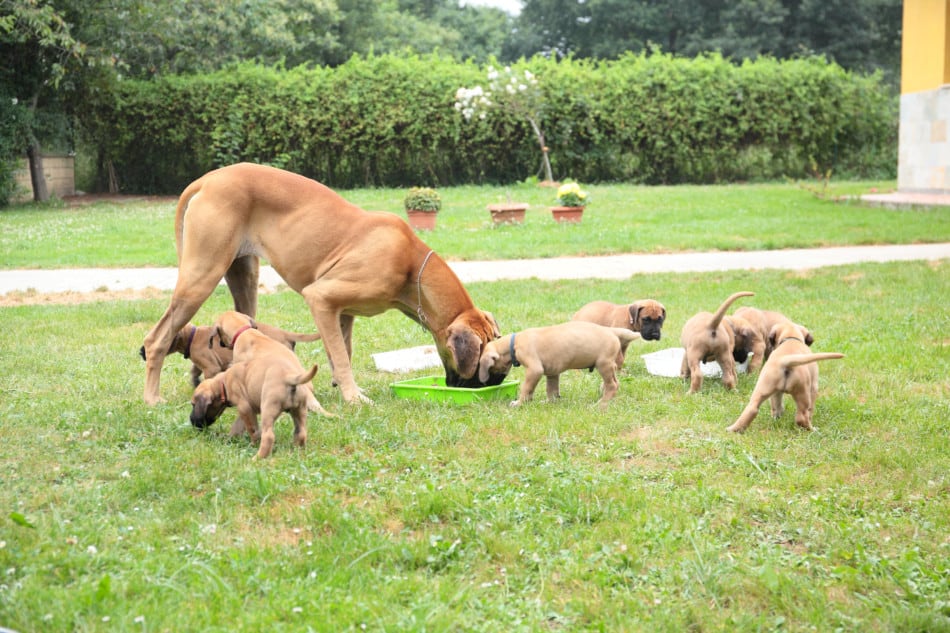
The Best Type of Dog Food for Great Danes?
Dog food options range from kibble and canned to semi-moist, raw (BARF), and home-cooked meals.
For Great Danes with sensitive stomachs, it’s wise to avoid semi-moist foods due to their high sugar and additive content that can cause gastric issues.
Canned foods, while sometimes suitable, are less economical and calorie-dense, making them less viable for long-term feeding.
This leaves us with kibble, raw, and home-cooked diets. Choosing among these should be based on your personal circumstances.
Good questions to ask yourself might include:
- How much time and effort due you have to put towards food preparation?
- Do you have the financial flexibility to spend more on food?
- How old is your Great Dane?
- Does your Great Dane have any other health considerations that should be accounted for?
Most of us may lack the time and resources to prepare a balanced raw or home-cooked diet for our Great Danes, but this doesn’t reflect a lack of care.
It’s important to be realistic about what we can manage, especially since a dog’s diet significantly affects its health.
In fact, according to the Merk Veterinary Manual, a European study of home-prepared diets found that 60% of dogs had major nutrient imbalances!
Ensuring a balanced diet for your dog is challenging. It requires a commitment to provide healthy meals 2-3 times daily for your dog’s lifetime, without the convenience of fast-food alternatives.
If you can invest the time and money and are adept at meal prep, a raw or home-cooked diet can be excellent! Just make sure to consult with a vet to ensure nutritional balance.
For those with the means but not the time or inclination for meal prep, consider services that deliver prepared dog food directly to your home.
Here is a fantastic option to consider:
Pet Plate delivers fresh personalized meals straight to your door that, completely removes the cooking hassle. If this sounds like a good fit for you, make sure to click here to take advantage of their current 40% OFF offer!
Pet Plate is a 100% human-quality dog food subscription service. All of the meals are made with USDA meat, fresh fruits & veggies, and a proprietary supplement blend.
For the rest of us…
A high-quality kibble will be the best choice for the majority of owners to ensure that their Great Dane is consistently eating a balanced diet.
Of course, the keyword to consider is “high-quality”. Let’s dive into exactly what makes for “high-quality” dog food!
My more detailed breakdown of each food type occurs later in the article, so keep reading!
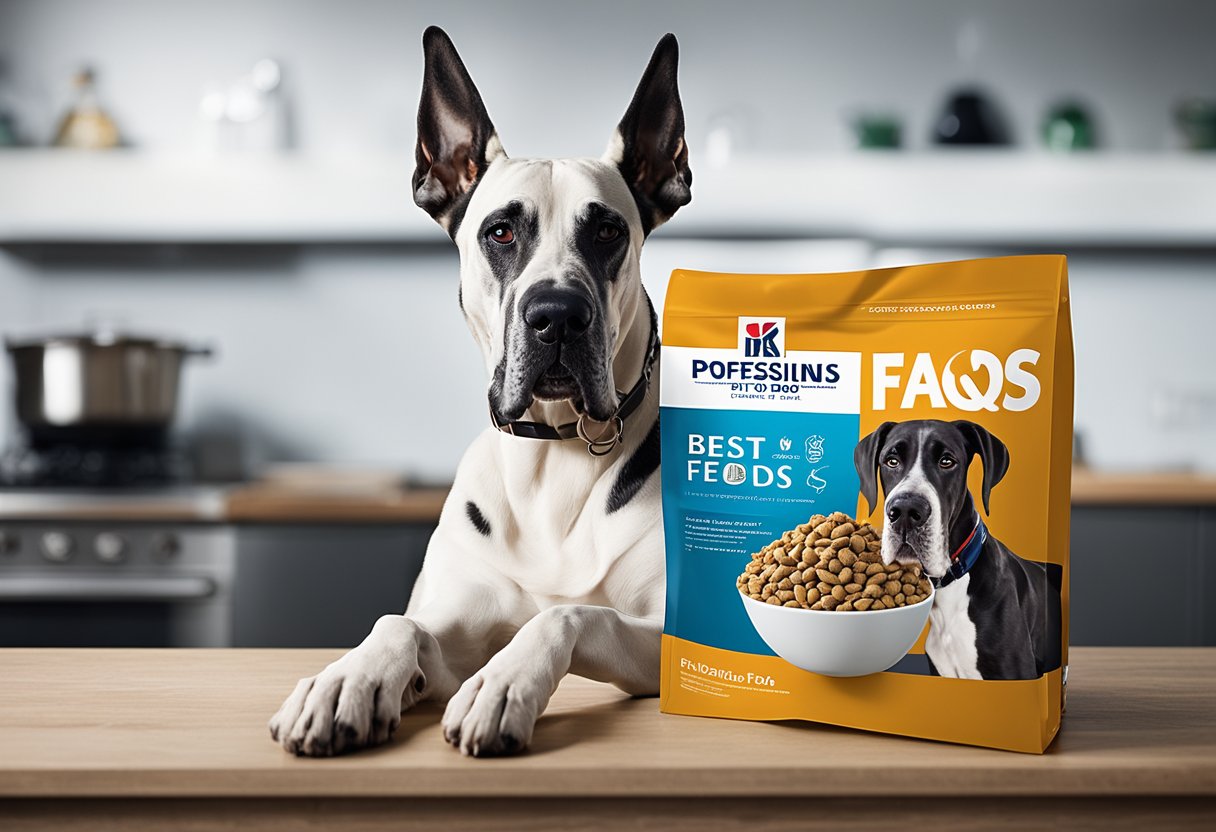
What to Look for in Good Dog Food
When choosing high-quality kibble, it’s crucial to know what to look for rather than relying on a pre-made list.
This knowledge empowers you to make informed choices for your pet. Let’s examine the key factors that determine the quality of dog food.
Protein Sources in Food
Selecting high-quality dog food means looking for multiple named animal proteins at the top of the ingredient list, as ingredients are listed by weight.
Avoid vague terms like “meat” which can indicate lower quality.
“Meals” should also be from specific animals, like “chicken meal” or “salmon meal,” and are acceptable as a secondary protein source. Fresh meat is preferable, and meals should not be the primary protein.
Steer clear of kibble listing meat or poultry by-products, especially near the top of the ingredients, as these can include less desirable parts. If by-products are included, they should appear towards the end of the list.
Technically, there are “regulated” sources of by-products that would be okay for your dog to consume e.g. organ meats.
However, the risk of unregulated sources such as hooves or hair making it in just doesn’t seem worth the risk when we’ve got so many good options available to pick from.
If the food does contain a by-product, it should not be one of the first found in the ingredient list. Ideally – it will be near the bottom.
Fat Sources in Food
The fat source in dog kibble is crucial.
Fat contains more than twice the calories per gram compared to protein, so quality is key.
Opt for named fat sources like chicken, duck, or salmon fat, and be cautious of generic “animal fat” labels.
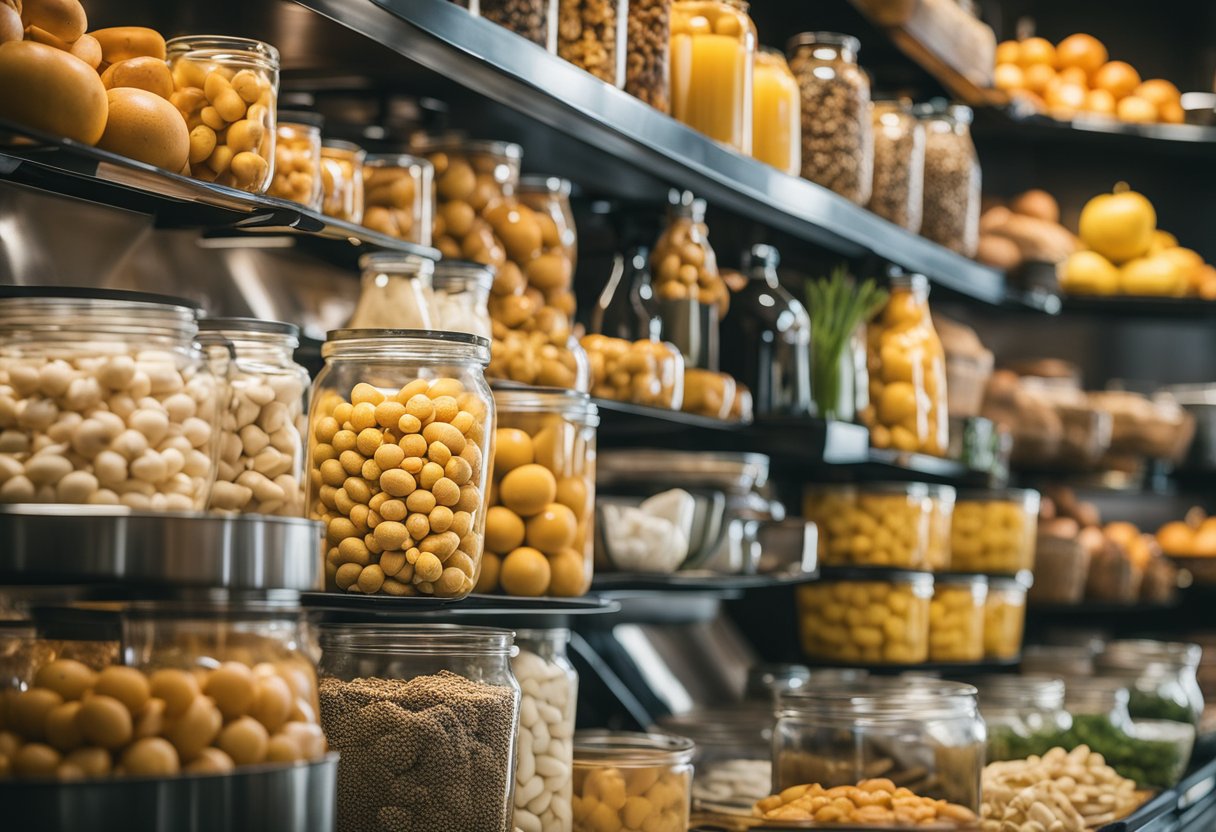
Carbohydrate Sources in Food
Carbohydrates are an essential macronutrient in dog food, providing energy and essential micronutrients from sources like vegetables, fruits, and grains.
Whole, unprocessed carbs are preferable!
Typical wholesome carb sources include:
- Peas
- Carrots
- Tomatoes
- Brown rice
- Spinach
- Barley
- Sweet potatoes
- Apples
- Blueberries
- Oats
Grain-free diets are not inherently better for dogs; grains are nutritious and support overall health.
Only avoid grains if your Great Dane has a confirmed allergy, which is rare (<1% of dogs). If choosing grain-free, ensure the food is nutritionally balanced.
Food Labeling
Dog food labels can reveal the quality of the product.
Look for statements like “meets the nutritional levels established by the AAFCO Dog Food Nutrient Profiles,” which means the food meets the standards set by the Association of American Feed Control Officials.
The “guaranteed analysis” on labels is also mandatory and indicates the minimum or maximum nutrient levels, such as “at least 26% protein” or “no more than 5% fiber.”
For further details on understanding this analysis, consult the AAFCO’s resources.
Macronutrient Ratios
As an extension of paying attention to the food’s labeling, you should also consider its macronutrient content. Most importantly, how much fat or protein does the food contain?
These numbers will have a large impact on growth rates. Great Danes already grow extremely fast and do not need any help in this department!
In fact, speeding up their growth as puppies will increase the chances for orthopedic issues such as knuckling over, bowed legs, HOD, and OCD.
This is most important during the puppy phase as this is the time that they will experience the most growth. Most growth-related diseases occur in the 2-7 month timeframe, with the most between months 2-4.
Ideally, look for food with protein under 27% and fat between 12%-20%.
Controlling fat is important because it’s so calorie-dense. Higher levels of fat mean greater overall calories and faster weight gain for your Great Dane.
This extra weight only places more stress on their rapidly growing joints and is not conducive to healthy development.
Micronutrient Ratios
Micronutrients are crucial for your Great Dane’s health, and kibble with diverse, wholesome carbohydrates usually provides these.
Yet, calcium and phosphorus deserve extra attention, especially to prevent orthopedic issues in growing dogs!
- For bone health, the ideal calcium content in Great Dane puppy food is 1% to 1.5%, with the lower end preferred.
- Phosphorus should be present in a ratio to calcium, with ideally 1 to 1.5 parts calcium for every part phosphorus.
Since that probably sounds trickly, let’s look at some quick examples.
| Calcium | Phosphorus Range |
| 1% | 0.67% – 1.0% |
| 1.25% | 0.83% – 1.25% |
| 1.5% | 1% – 1.5% |
While generic puppy formulas are frowned upon for Great Danes due to their high protein content, certain specially formulated blends do a great job of helping to keep these calcium and phosphorus ratios in check.
Once your Great Dane finishes most of their growing around 18-24 months, you can safely switch them over to adult blends.
If you’re looking for a simple guide on how to best care for a Great Dane, then make sure to take a look at my book The Great Dane Puppy Handbook.
The Great Dane Puppy Handbook takes all of the need-to-know Great Dane info and packages it together into a single, concise resource. Save yourself time, money, and frustration by avoiding the most common mistakes made by Great Dane owners!
Large/Giant Breed Specific Dog Food
While selecting a kibble that meets all of the criteria we have discussed so far will go a long way towards ensuring your Great Dane’s health, there’s a shortcut to saving yourself considerable research time.
Ready for the secret…?
Start your search by looking at kibbles specifically formulated for large or giant breeds!
Thankfully, manufacturers have caught on that large and giant breeds have different nutritional requirements for optimal health and, as such, have created specific formulas.
While you can certainly find “regular” kibble that meets the same criteria, this is a good way to save yourself time.
Results: Best Food for Great Danes
Using the guidelines established above, I researched almost 100 large breed-specific foods found on
Why
Aside from being extremely competitive on prices, their scheduled auto-shipping really makes things easy.
Leveraging auto-ship also comes with an additional 5% discount, so yet another reason to use it! Better yet, they’ve got a promo running right now that will get you 35% OFF your first auto-ship. Click here to take advantage of these extra savings.
Let's face it - Danes eat a LOT of food! Save yourself some serious cash by signing up for Autoship and getting an additional 35% off your first one!
Without further ado, let’s jump in and take a look again at the best available kibble options for Great Danes.
Recommended Food for Great Danes
All of the links below will take you directly to their listing on
- Wellness Large Breed Complete Health Adult Deboned Chicken & Brown Rice
- Diamond Naturals Large Breed Adult Chicken & Rice
- Health Extension Large Bites Chicken & Brown Rice
- American Journey Large Breed Chicken & Brown Rice
- American Journey Large Breed Salmon & Brown Rice
- Purina ONE SmartBlend Large Breed
While all of these passed the same criteria for selection, I’ll share what we’ve been using for the last several years.
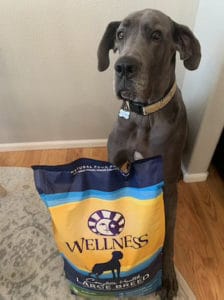
While it’s not the cheapest option on the list, “wellness large breed Complete Health Adult Deboned Chicken & Brown Rice” has been our go-to for many years.
In addition to their use of fantastic ingredients, Wellness also has a fantastic reputation in the pet food industry.
In typical Daney fashion, Gus was not amused when it came time to take a photo of her with the latest
This natural dry food is specially formulated to provide whole-body nutritional support for your large breed dog. It's designed to encourage a strong immune system, optimize energy levels and ensure a healthy skin and coat while promoting whole body health.
I highly recommend using Autoship with Chewy to save yourself an extra 5%!
Best Grain-Free Food for Great Danes
While I don’t think grain-free food is necessary for most dogs, I did come across two with adequate nutrient profiles. Keep in mind that grain-free diets have been tied to cases of DCM, so make sure to consult with your veterinarian before making this switch.
In the event that your vet does recommend grain-free food, these are two that I would recommend looking into.
- Simply Nourish Grain-Free Chicken with Peas & Potatoes Recipe Large Breed
- Nature’s Recipe Large Breed Grain-Free Chicken, Sweet Potato & Pumpkin
While good kibble is never cheap, it will undoubtedly save you money in the long run by improving your Great Dane’s health.
Veterinarian visits add up much faster than food bills, and without the pain and heartache of watching your dog’s health suffer.
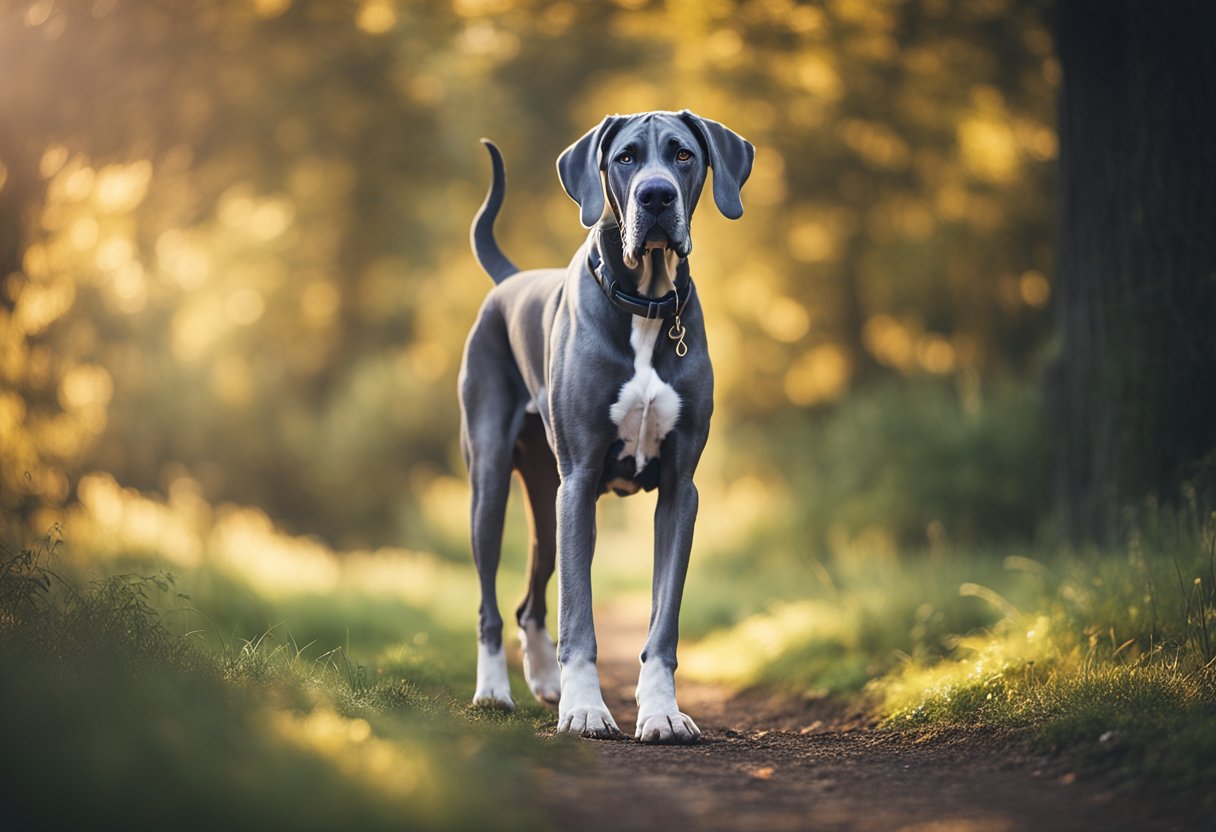
Types of Dog Food for Great Danes
Type 1: Kibble
Kibble is the most common type of dog food found in the United States. It can be manufactured in large quantities and has a long shelf life, making it one of the cheapest options.
Walking down a grocery or pet aisle, you will likely see dozens of kibble brands. This count can quickly balloon to hundreds of options when looking at online retailers such as
Kibble is created by mixing together the ingredients and crushing them to create a dough-like compound. The “dough” is then fed into a pressurized machine where it’s cooked and extruded into small bits of kibble.
Pros
- Cheap
- Good shelf life
- Easy to store
- Can be found in many locations
- Wide variety of brands and options to choose from
- Simple portion management
- Formulas available for different stages of life
- Easy to take on the go or travel with
- Simple cleanup after or around mealtime
Cons
- Dry composition requires extra water intake to make up for lost fluids
- Product recalls are common due to contamination and other manufacturing mistakes
- Selecting one can be tough due to a large number of options
- Very little regulation and oversight around food quality
- While not proven, the combination of low-quality nutrients and cereals is suspected to play a factor in bloat
Type 2: Canned Dog Food
Canned food can almost be considered the wet equivalent of kibble. It’s produced in mass quantities and generally available in a variety of locations and brands.
Canned dog food is created by blending together raw and sometimes frozen meats. These are then ground into small bits and then often supplemented with vitamins, minerals, or grains.
This final mixture is then mixed and cooked before being canned. The cans are sterilized through heating before finally being shipped out for distribution.
Pros
- Increases the dog’s water intake
- Good shelf life
- Can be found in many locations
- Soft consistency makes it easier to eat for dogs with oral issues
- Stronger smells may make it more appealing to dogs not wanting to eat i.e. elderly, sick, etc…
Cons
- More expensive than kibble
- Lower calorie density than kibble
- Can leave a mess to clean up
- Requires additional dental due diligence to prevent periodontal disease
- Needs to be used quickly or refrigerated after opening
- Not typically used as a standalone diet. Often combined with kibble or supplementary food
Type 3: Semi-Moist Dog Food
Interestingly, this type of dog food was popularized in the 1960s and 1970s and came in a hamburger-like patty. You may also see it referred to as “soft-moist” food.
As the name implies, semi-moist acts as the happy middle ground to dry kibble and wet canned food. It contains more water than kibble but less than canned (usually in the 60% – 65% range).
They do not require refrigeration and use preservatives to extend their shelf life.
Pros
- Easy to chew for dogs with oral issues
- More appetizing than dry kibble
- Less messy than canned food
- Cheaper than canned food
Cons
- More expensive than kibble
- High sugar and salt content can lead to loose stool for Great Danes
- Requires additional dental due diligence to prevent periodontal disease
- Many contain artificial flavorings and colorings
Type 4: Raw diet (BARF)
The concept behind a raw diet is that your dog eats foods more closely aligned to their ancestral diet. In other words, they primarily eat meat, organs, and bones as the bulk of their diet.
This often also includes a small portion of vegetables and fruits as well.
Contrary to what your own stomach may be telling you right now – this is not why it’s also often called “BARF!
It’s an acronym for “Biologically Appropriate Food” and “Bones and Raw Food”.
Now that we’ve cleared that one up…
A typical raw diet consists of the following:
- 70% muscle meat
- 10% bone
- 5% liver
- 5% other secreting organs
- 10% fruits and vegetables
Note: For more details on a raw diet, please refer to my dedicated article here.
Pros
- Easier weight management
- Many owners report better musculature and healthier coats after switching to a raw diet
- Less poop 😉 (yes, I’m definitely keeping this one on the list!)
- Full control over your dog’s diet
Cons
- Increased risk of exposure to harmful bacteria that could make you and your dog sick
- Requires more diligence to maintain a proper dietary balance
- Switching over may result in periods of diarrhea before the dog’s body adjusts
- Typically more expensive
Type 5: Home-cooked Dog Food
This option needs no introduction because it’s what most of us do every day 😉 Like a raw diet, you can choose to simply take matters into your own hands and cook food for your dogs.
A common example of this type of meal would be boiled chicken and rice or sweet potatoes. However, the options are virtually unlimited.
Pros
- Full control over your dog’s food
- Cheaper than a raw diet
- Less chance of bacterial exposure due to cooking
- Cooking softens foods which can make them easier to consume for dogs with oral issues
Cons
- Requires more diligence to ensure proper dietary balance
- Additional time spent planning and prepping meals
- More expensive than kibble food
- This may lead to more food stealing and begging (you can train them not to do this, but that’s also more potential work)
Note: We all lead busy and stressful lives, and worrying about our Great Danes is just another piece of this puzzle. If you’re looking for a guide to simply walk you through everything that you need to know from A-Z about Great Danes, then you should absolutely look at my ebook “The Great Dane Puppy Handbook“. It’s exactly what you need to feel calm and confident about caring for your dog.
Avoiding Harmful Ingredients in Dog Food
As a Great Dane owner, I know how important it is to provide my furry friend with the best dog food possible.
However, not all dog foods are created equal and some may contain harmful ingredients that can negatively affect my dog’s health. That’s why it’s crucial to read the ingredient label and avoid certain ingredients.
Here are some harmful ingredients that you should avoid when choosing dog food for your Great Dane:
Artificial Colors
Artificial colors are often added to dog food to make it look more appealing to humans. However, these colors are not necessary for your dog’s health and can actually be harmful.
Some artificial colors have been linked to cancer and other health problems in dogs. Therefore, it’s best to choose dog food that doesn’t contain any artificial colors.
Artificial Flavors
Artificial flavors are often added to dog food to make it taste better. However, these flavors are not necessary for your dog’s health and can actually be harmful.
Some artificial flavors have been linked to allergies and other health problems in dogs. Therefore, it’s best to choose dog food that doesn’t contain any artificial flavors.
Artificial Preservatives
Artificial preservatives are often added to dog food to extend its shelf life. However, these preservatives are not necessary for your dog’s health and can actually be harmful.
Some artificial preservatives have been linked to cancer and other health problems in dogs. Therefore, it’s best to choose dog food that doesn’t contain any artificial preservatives.
In conclusion, it’s important to read the ingredient label when choosing dog food for your Great Dane.
Avoiding harmful ingredients such as artificial colors, flavors, and preservatives can help keep your dog healthy and happy.
Maintaining a Healthy Weight and Joint Health

As a Great Dane owner, it’s important to maintain your dog’s healthy weight and joint health. Great Danes are prone to gaining weight, which can put extra strain on their joints and lead to health issues such as arthritis.
Here are some tips to help maintain your Great Dane’s healthy weight and joint health:
Feeding a Balanced Diet
Feeding your Great Dane a balanced diet is crucial for maintaining a healthy weight and joint health.
Look for dog food that is specifically formulated for large breeds, as they have different nutritional needs than smaller dogs.
A diet that is high in protein and low in fat can help your Great Dane maintain a healthy weight. Additionally, look for dog food that contains glucosamine and chondroitin, which can help support joint health.
Incorporating Exercise
Exercise is important for maintaining a healthy weight and joint health. Great Danes require regular exercise to stay healthy and happy.
Take your Great Dane for daily walks or runs, and consider incorporating other activities such as hiking or swimming. However, be mindful not to over-exercise your Great Dane, as this can also lead to joint issues.
Supplementing with L-Carnitine
L-Carnitine is an amino acid that can help support healthy weight management in dogs. It works by helping the body convert fat into energy, which can help your Great Dane maintain a healthy weight.
Look for dog food that contains L-Carnitine, or consider supplementing with it if your Great Dane needs extra support in maintaining a healthy weight.
Regular Vet Check-Ups
Regular vet check-ups are important for maintaining your Great Dane’s overall health, including their weight and joint health.
Your vet can help you develop a plan for maintaining your Great Dane’s healthy weight and joint health, and can also monitor for any potential health issues.
In summary, maintaining your Great Dane’s healthy weight and joint health is crucial for their overall well-being.
Feeding a balanced diet, incorporating exercise, supplementing with L-Carnitine, and regular vet check-ups can all help support your Great Dane’s healthy weight and joint health.
Understanding Food-Related Health Issues in Great Danes
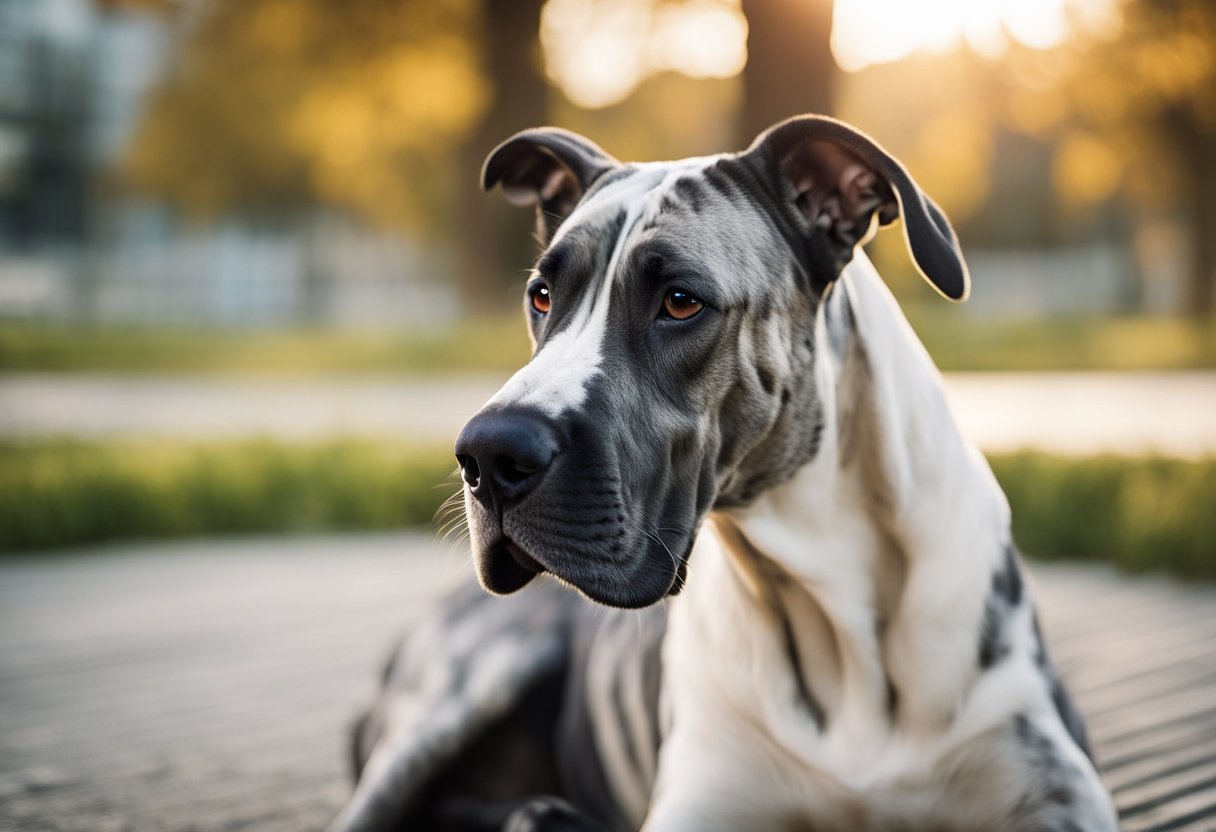
As a Great Dane owner, it’s important to understand the potential food-related health issues that your dog may face.
Here are some of the most common health concerns related to diet in Great Danes:
Dilated Cardiomyopathy
Dilated cardiomyopathy (DCM) is a serious heart condition that can affect Great Danes. It causes the heart to enlarge and weaken, which can lead to heart failure. Recent studies have linked DCM in dogs to a deficiency in the amino acid taurine.
To help prevent DCM, it’s important to choose a dog food that contains adequate levels of taurine. Look for dog foods that list taurine as an ingredient, or consider adding a taurine supplement to your dog’s diet.
Bloating
Bloating is a common health issue in Great Danes that can be caused by eating too quickly or consuming large amounts of food. It occurs when the stomach fills with gas and twists, which can be life-threatening if not treated promptly.
To help prevent bloating, it’s important to feed your Great Dane smaller meals throughout the day instead of one large meal. You can also use a slow feeder bowl to help your dog eat more slowly and reduce the risk of bloating.
Taurine
Taurine is an essential amino acid that plays a critical role in your Great Dane’s health. It’s important for maintaining healthy eyes, muscles, and heart function. Great Danes are at a higher risk for taurine deficiency, which can lead to serious health issues like DCM.
To ensure that your Great Dane is getting enough taurine, choose a dog food that lists taurine as an ingredient. You can also consider adding a taurine supplement to your dog’s diet.
By understanding these common food-related health issues in Great Danes, you can make informed decisions about your dog’s diet and help keep them healthy and happy.
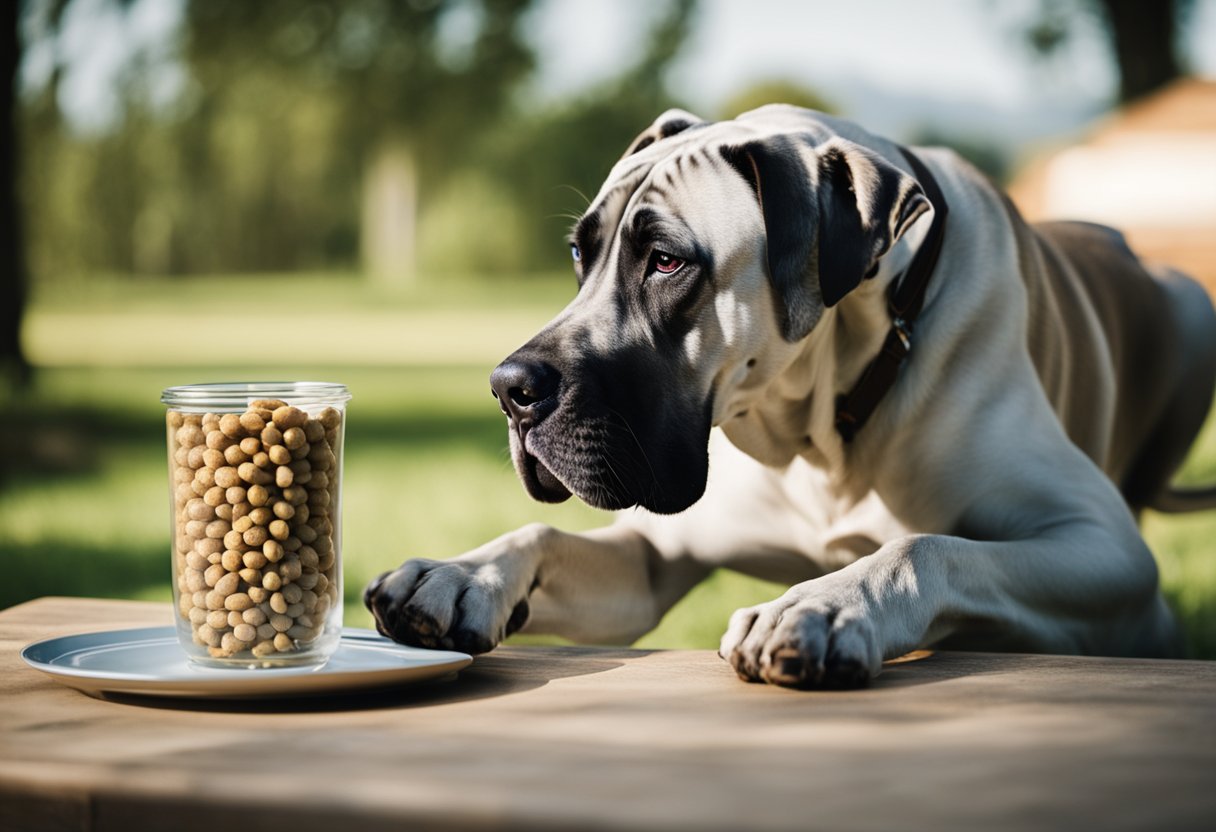
Great Dane Care and Feeding Tips
As a Great Dane owner, I know that providing proper care and nutrition is essential for maintaining the health and well-being of these gentle giants.
Here are some tips to help you keep your Great Dane healthy and happy:
Consult with a Veterinarian
First and foremost, it’s important to consult with a veterinarian to determine the best diet and feeding regimen for your Great Dane.
They can provide valuable advice on the nutritional requirements of your dog based on their age, weight, and overall health.
Consider the Immune System
Great Danes are prone to certain health issues, such as bloat and hip dysplasia, which can be influenced by their diet.
To support their immune system, look for dog food that contains antioxidants and essential fatty acids, such as DHA.
Opt for Appropriate Kibble Size
Great Danes have large jaws and mouths, so it’s important to choose kibble that is appropriate in size.
Large kibble can help promote dental health and prevent choking hazards.
Consider Energy Needs
Great Danes have lower energy needs than other breeds, so it’s important to avoid overfeeding them.
Feeding your Great Dane the appropriate amount of food can help prevent obesity and other health issues.
Provide Plenty of Water
Great Danes need access to plenty of fresh water throughout the day. Make sure to provide clean water in a large bowl that is easily accessible to your dog.
By following these tips and providing your Great Dane with proper care and nutrition, you can help ensure that they live a long and healthy life.
For more information on Great Dane care, consider subscribing to the Great Dane Care Newsletter or consulting with a veterinarian.
Frequently Asked Questions
What are the nutrition requirements for Great Danes?
Great Danes are a large breed of dog that requires a specific diet to maintain their health and well-being. They need a balanced diet that is high in protein and low in fat.
This helps them maintain a healthy weight and avoid obesity, which can lead to a variety of health problems. Great Danes also need plenty of vitamins and minerals, particularly calcium, which is important for their bone health.
What are some homemade dog food recipes for Great Danes?
It is important to consult with a veterinarian before making homemade dog food for Great Danes.
However, some recipes that are generally safe and nutritious for Great Danes include a mixture of cooked chicken, brown rice, and vegetables such as carrots and sweet potatoes.
Another recipe is a mixture of cooked ground beef, quinoa, and green beans.
What should be included in a Great Dane’s diet to keep them healthy?
A healthy diet for a Great Dane should include high-quality protein sources such as chicken, beef, and fish.
It should also include complex carbohydrates such as brown rice and sweet potatoes, as well as plenty of vegetables for vitamins and minerals.
It is important to avoid feeding Great Danes table scraps and human food, as this can lead to obesity and other health problems. Additionally, it is important to provide fresh, clean water at all times.

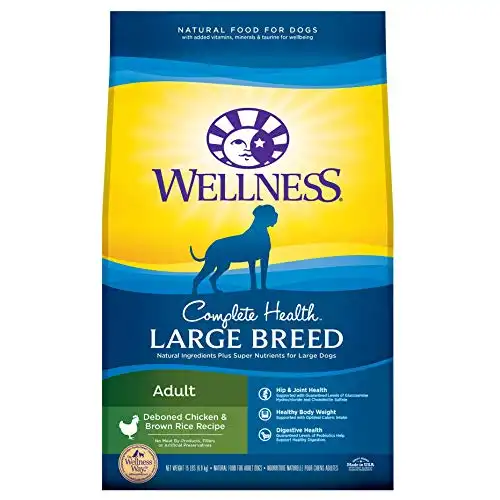

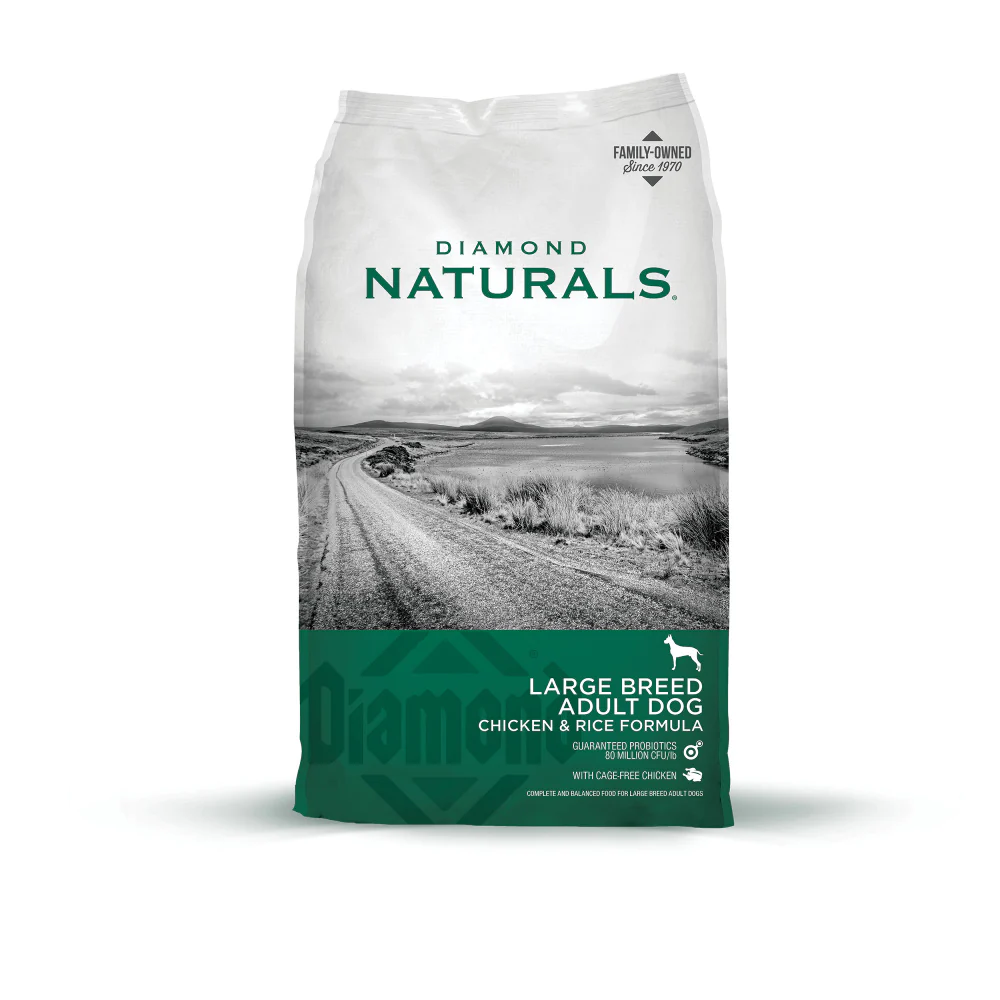
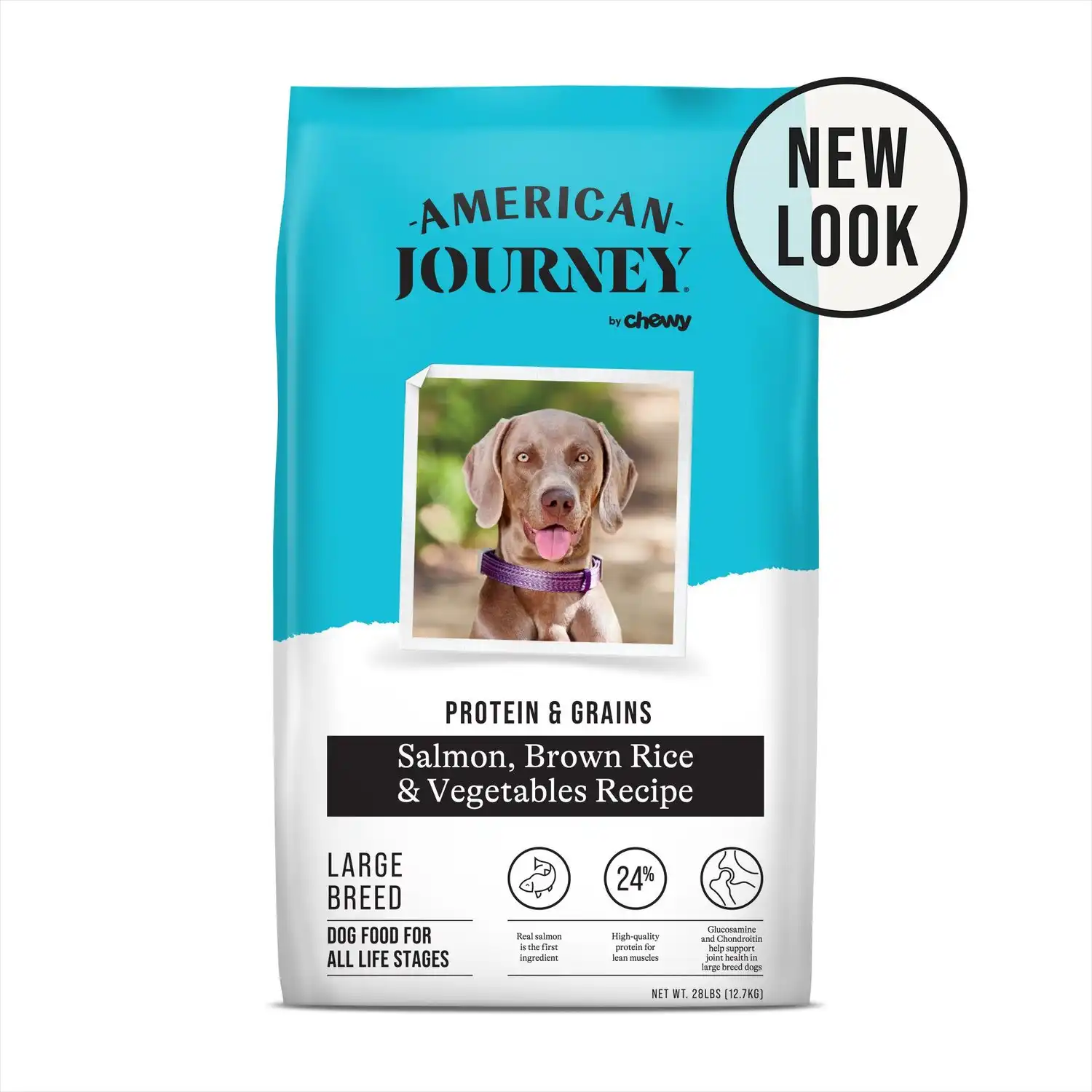
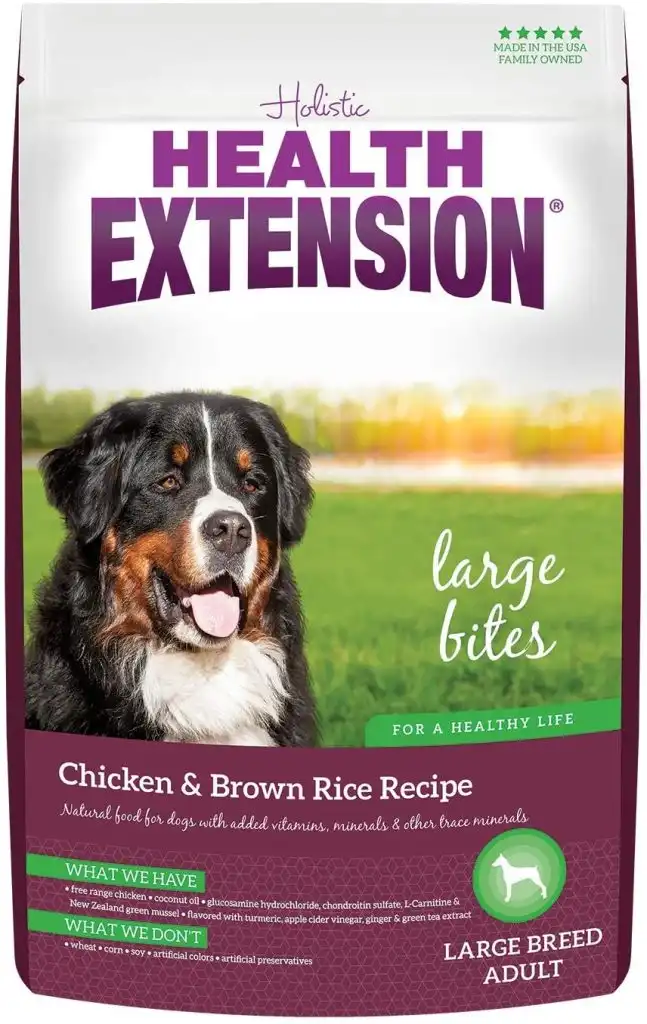

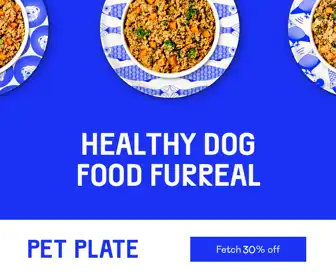
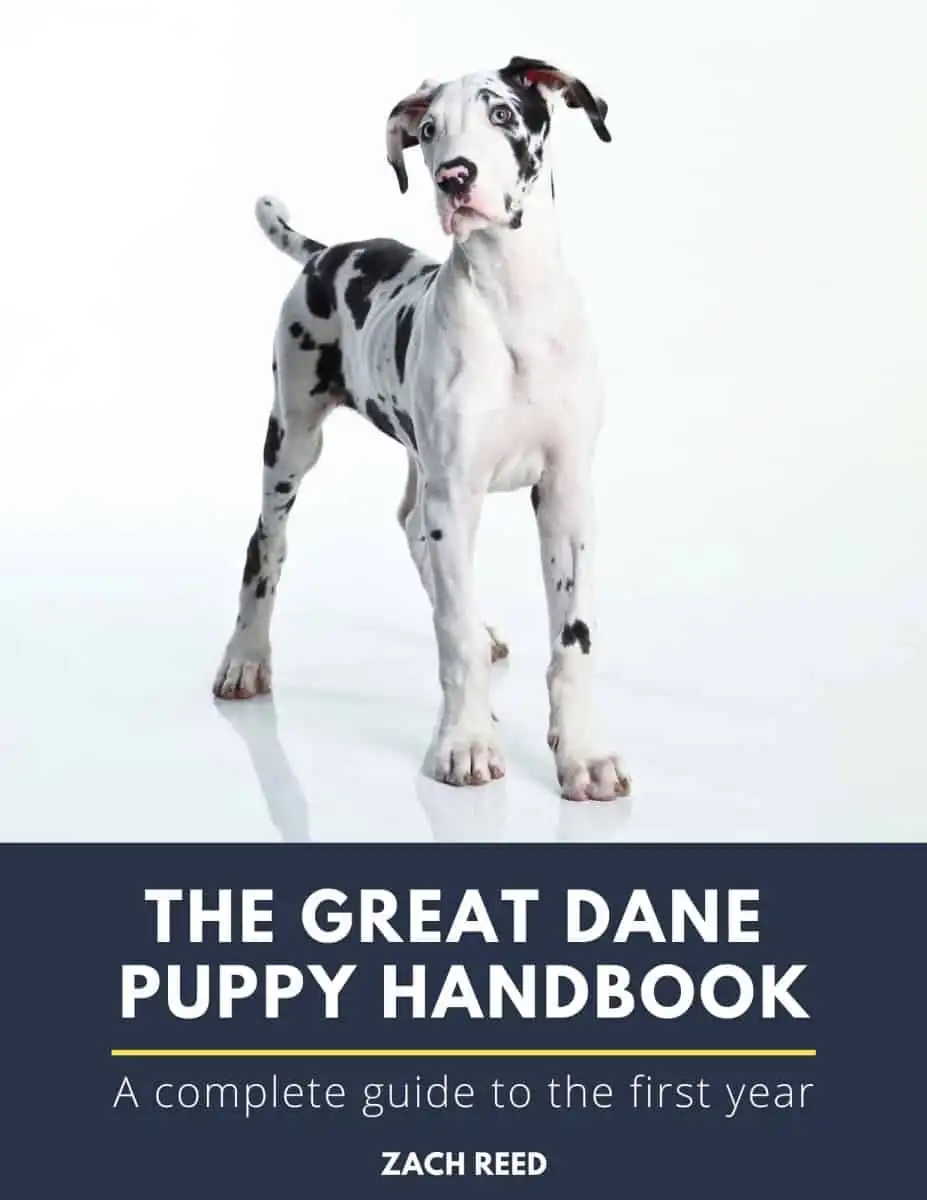

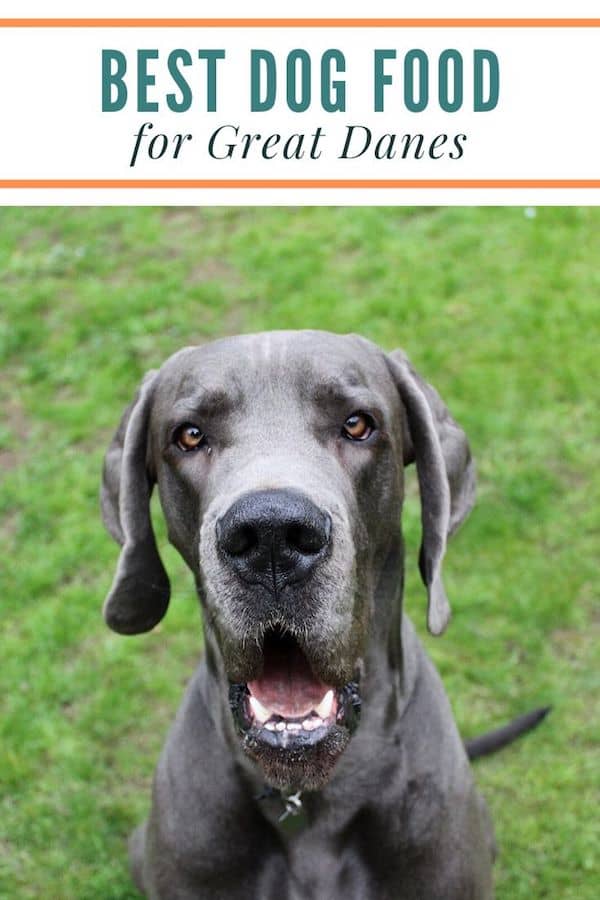
I’m really surprised by this article. In it, you totally gloss over the fact that Danes are genetically prone to Dilated Cardiomyopathy (a heart condition) and that many foods which are grain free or may contain grains but still are heavy in peas or any legumes, potatoes and sweet potatoes have been linked to an ever-increasing number of cases of nutritionally mandated DCM. If the breed is already prone to this condition, feeding brands that are on the FDA’s suspect list (with cases directly attributed to feeding these brands)–typically brands who do minimal ongoing batch testing, virtually NO feeding trials, and have no full-time certified veterinary nutritionists on staff to oversee formulation–is tantamount to asking for trouble. I find it a bit irresponsible on your part.
Hi Mary,
Thanks for bringing up this important topic. In the context of an already 3,000+ word article, trying to cram in a section about DCM would be doing it a disservice. It really deserves its own dedicated page and that’s why it was not covered in detail here.
The two grain-free food brands recommended are not on the FDA list, and were listed as considerations in the event that your veterinarian recommends a grain-free diet. Without skipping the topic entirely, that seems as balanced a recommendation as one can make.
Can you tell me what you feed your Dane? Mine might be having some allergies and he doesn’t love what I’m giving him now. Any help is appreciated!!
What would you recommend to avoid this?
Is canidae all life stages a good dog food for
Danes
This is what I feed mine and 7 other of my dogs as well and they all over it and do well on this food. I feed the multi protein version and they all love this food.
Love your YouTube and blog! I have been feeding my Great Dane “Solid Gold” for a few months now. Check it out, I’m curious about your opinion. Very interesting story behind the food. Sissy McGill is the creator/owner. She is now 86, her danes were the reason for making the food. Anyway, let me know what you think.
Thanks, glad to hear that you’re enjoying it! Which Solid Gold recipe are you feeding your Dane?
I use solid gold (lamb rice and pearled barley) too! but I do mix in raw eggs with shells, raw chicken/bones, and raw meats 3 times a week now that the pups older. But so far its the best food in my personal opinion, no loose stools and I like to think its because of the pre/probiotics that are but into it! so definitely keeps that gut and other than vaccines I never had any knuckling or other issues that would need a vet. 🙂
Hi, love your YouTube and your blog! It’s been very helpful for us. We have a 8 month old Great Dane. We’ve been feeding him Nutri Source Large Breed Adult Chicken and Rice Formula kibble food for few months now. We are giving him his food 4 cups at 7am and 4 cups at 7pm. We don’t give him human food much, we give him maybe twice a week. Lately he is not eating his breakfast, sometimes he eats a little and just not finish it. He wants to play instead. He is also not getting a lot of dog treats. However, he always finish up his dinner. I don’t want to give him all the 8 cups of food at his dinner because i heard that feeding a lot is dangerous for the danes. I’ve been also thinking to changing his food and after that maybe he might eat his breakfast. I saw your recommendations about the kibble food. I am in between the Wellness and Purina.
As you can understand, i am a bit confused and i am open to any kind of advice. Sorry in advance if i made you confused as well 🙂 Thank you so much! Have a great dane!
Appreciate the kind words! Being picky around breakfast is common, and as long as it doesn’t go on for too long it’s usually not something to be worried about. This article covers more detail about what to do if they don’t eat a meal -> https://greatdanecare.com/feed-great-dane-puppy/
Hi and Thank you Zach! I was wondering if you had any experience or analysis of Kirkland (Costco) brand food. It looks the Lamb and Rice could be a good large breed fit. Is there any Kirkland kibble you’d recommend?
Kirkland’s Lamb and Rice formula has good macros and decent ingredients, but strangely it doesn’t list the calcium/phosphorus amounts. Their “Signature Adult Formula Chicken, Rice and Vegetable” blend looks like a good option as well if you want to get the food from Costco.
Just looking for a quick clarification… based off of your recommended range for protein and fats, most puppy foods are too high. Would it be better to put a puppy straight onto the adult formula then? Most of the puppy foods I’ve looked at are closer to 27-28% protein.
Correct – that’s what I do!
Are there differences in specific nutrients needed for puppies that are not found in the adult foods?
I’ve been giving my big boy (Augie) and girl (Daisy) Royal Canin Great Dane special. It has large chunks which slows down their eating. They seem to be doing well but I’ve run into a problem where Amazon ships torn/damaged bags. I am going to try Wellness brand via Chewy’s. While any feeding regimen that yields a beautiful dog like Gus can’t be bad, I think that regular exercise and plain old love and attention is equally necessary :}
I started giving my big furkidz the Wellness brand suggested. This was in part because Amazon was damaging the food in shipping (bags torn open, food loose). While I wouldn’t say that Chewy is a lot more careful in shipping (FedEx), at least the bags are not damaged (could be a fundamental issue with Royal Canin packaging). The furkidz like the Wellness food though they have been transitioning, so haven’t been eating it long enough to draw conclusions as yet.
I’ve been giving our big girl/guy this food for right at two months now (transitioned from Royal Canin GD kibble). They definitely like the food and both seem well and energetic except my big guy seems to be having soft stools (he gets pumpkin at nearly every feeding). Our Vet is suspicious of food allergies specific to him so I might transition them back to Royal Canin GD kibble. I much prefer Chewy to Amazon as Chewy have never torn a bag of dog food. Both Royal Canin and Wellness are much more expensive at brick+mortar stores than on-line.
What are your thoughts on Wellness CORE Wholesome Grains Original Recipe High Protein Dry Dog Food for my 4 year old Dane? I saw that it had a high amount of glucosamine and chondroitin sulfate for her joints.
Also what are your thoughts on Blue Buffalo Life Protection Formula Large Breed Adult Lamb & Brown Rice Recipe Dry Dog Food and Blue Buffalo Life Protection Formula Large Breed Adult Fish & Oatmeal Recipe Dry Dog Food?
Could you tell me your thoughts on Victor high energy (red bag) I have a year and half old European Dane I feed her Victor I have only had her for a month. When I got her she was very thin 111 pounds she was on diamond naturals skin and hair I changed her over to Victor she was eating great about 5 to 6 cups in the morning 5 to 6 cups in the evening then she slowed down to around 3 to 4 cups morning 3 to 4 cups evening then she got to where she didn’t eat much in the morning so I mixed 1 or 2 tablespoons of unrefined coconut oil in the morning food which she liked and now won’t eat unless I put it in her evening food to. I also give her salmon chews because she sheds horrible bad. So I was wondering if Victor red bag , 2 to 4 tablespoons unrefined coconut oil and 3 salmon chews ( 100 paws omega and salmon health chews + him personally oil ) are all ok. Thanks
That should say omega and salmon health chews + hemp oil
Hello,
I’m picking up my new Great Dane Puppy in a few weeks and was wondering what your thoughts on feeding her the Wellness Puppy food? Should I only do adult? Also, at 8 weeks how much should I be feeding her?
Thanks
That’s what I do! You can follow the weight-based guidelines on the food packaging, or the general recommendations listed here -> https://greatdanecare.com/feed-great-dane-puppy/
Thank you. I am going to go with Wellness too for my Dane Puppy Banshee.
Hi there! Loving the site and all the recommendations/training tips. I may have picked up almost all the recommended hygiene supplies, ha.
We get our Great Dane Puppy here in a few days and he’ll be 8 weeks. Conveniently, my Pitbull is already on Wellness, but he does the Whitefish & Sweet Potato (Wellness Complete Health Natural Dry Dog Food, Whitefish & Sweet Potato) as he has allergies toward Chicken. I checked the ingredient list/percentages to the “Adult Deboned Chicken & Brown Rice” and, as it is the same brand/type, they are pretty similar. I was just curious if you had any thoughts on the Whitefish & Sweet Potato diet versus the Chicken & Rice. I know the fish will help with the coat too as it does with my Pit.
Seems like everything should be fine but I figured I would ask as you didn’t put any other Wellness Floavors on your list.
Thank you!
What is your take on “Wellness Complete Health Adult Deboned Chicken & Oatmeal Recipe Dry Dog Food” vs the Wellness for large breed ? Looking at the ingredient list it appears it fits all the proper amounts and even little lower than the large breed version in calcium. Is there something I am not seeing why this would not be better or why it would not work for a large breed ? thanks !
It’s calcium and phosphorus are a little lower than ideal, and its calories per cup is a bit higher than I like to see.
With a proper kibble (one from your list!) would you still recommend a calcium supplement. My breeder is sent home a long list of supplements, and a food recommendation ( Diamond Hi-Energy Sport- chicken by product is the first ingredient). But I have read that too much calcium can be bad news for growing pups too.
Hi there! Thank you so much for providing such great information. We have an 18 week old female who is roughly 46 lbs. We currently have her on The Farmers Dog food and Nutro Ultra large breed puppy food. What are your thoughts on the Farmers Dog food vs. Pet Plate? Also, since we are mixing fresh food with Kibble how much of each would you feed her?
I was so hoping to see my dog’s food on your list. But then got a little worried when it wasn’t. Perhaps if you do any updates you might look into Gentle Giants as they say “specifically formulated for Great Danes.” Interesting back story, but I didn’t care about that… it was all about the food and proclaimed healthy long life for my Great Dane. https://www.gentlegiantsdogfood.com/
We have been dedicated to Victor Hero Grain Free for all our dogs from pup to senior. It’s not on the FDA list and it’s primarily beef and fish which helps since many dogs have allergies with chicken. All our dogs are healthy and energetic . We rescued a Shepherd diagnosed with cancer. We were told she only had 3 weeks to 3 months to survive. Once on the Victor Hero, she flourished. She was strong enough to be operated on, removing the mass and her mastitis. We celebrated her one year with us a couple months ago and is doing great.
I’ve had all of my dogs on Purina One for years including my Dane. I’ve been told by several vets that Purina One and Hills are the only 2 who do rigorous safety testing on their foods to ensure safety. The FDA does not regulate dog food so that’s why there have been so many recalls and dogs who have died from their food. Purina One never shows up on those lists but some of the more expensive foods do. My dogs love it and my 2 oldest dogs who just passed lived to 13 and 15 minimal health issues throughout their lives (neither were Danes). My Dane is 8 now and in great shape. I recommend Purina One to anyone who wants quality dog food at a reasonable price.
Hi.
My almost 2 yo Dane neutered male has switched to adult food.
We were feeding large breed Holistic Select Lamb and Oatmeal Puppy through out him growing. I haven’t been fully in love with it and he’s a picky eater so we’ve had to be inventive at times.
I’ve been on the search for a lamb large breed mostly NATURAL/HOLISTIC ingredients almost since I’ve got him and found no luck that had LAMB and not just lamb meal as an ingredient. I would like to keep him on lamb since he’s had no dietary issues with it and worried about allergies to chicken, reading several locations and from vet that that could be high on the list for danes if present.
I have since switched him to Fromm Family Large breed chicken because that’s all that’s in the line and I was attracted to the ingredients. Since switching I have noticed him shaking his head a little bit more. No issues with scratching or hair issues or anything visually alarming in ears. They get cleaned 1-2 a week, per vet. I am awaiting an appointment to get checked for ear issues to rule that out as well as ordered a food intolerances test to see for sure but in the mean time…. Do you know of any Large Breed Adult Holistic ingredients with Lamb protein as first ingredient? It’s becoming like a needle in a haystack.
Thanks.
I just got a Great Dane Puppy (now 3 months old) and changed her food from the generic the breeder was using. Another research column I read recommended Blue Buffalo Wilderness Rocky Mountain Recipe with Beef for Giant Puppies. I think its grain free also. You recommend the Wellness brand and talk about not using puppy food. The main difference in nutrients I caught between the two is that Blue Buffalo has 32% protein and Wellness has 26%. Do you think I should go through changing my puppy’s diet to change food (again) or do you think the Blue Buffalo is okay and not enough protein to hurt the dog??
Thank you so much for your answer in advance.
Petco now has a large breed Puppy & Adult . It is a chicken & brown rice. Anyone have thoughts on it or feeding it now ?
Thanks
Hello- can you please provide options for canned food? I would like to mix it in with their kibble as I’m having trouble finding a kibble brand that she enjoys for an extended amount of time
Hello!
I follow your weekly blog for my grand pup, Cash.
He’s a 6-year-old Dane.
We feed him Purina One Vitality for Mature dogs, 7+.
Because Danes don’t generally have a long-life span, the vet that we use said that its ok to give him Senior food now.
What are your thoughts on this?
Hi, im curious about why there is such a large percentage difference between raw food protein and kibble protein. For kibble is says to look for protein around 27% and for raw its 70% muscle meat 5% organ meat. Im just so confused about this. Im new to homemade food but i want to get it right.